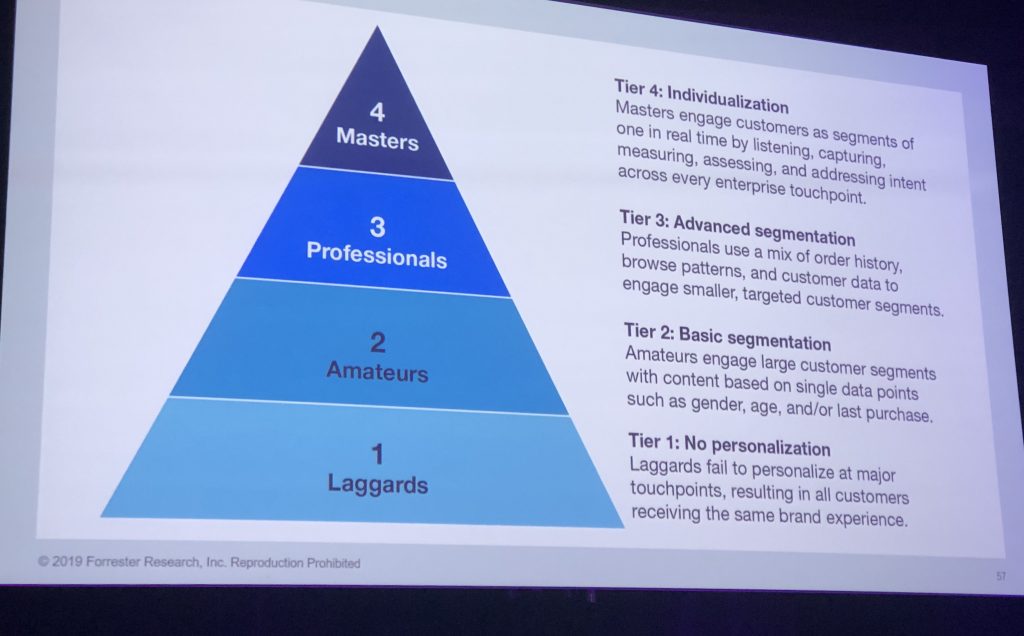Brendan Witcher, VP and Principal Analyst from Forrester talked about relevance and individuality as the key to personalization. He went into depth on how individualization is the new bar for relevance. The digital buyer is mythical. In fact, buyers experience brands in digital and real-life experience.
You can no longer compare yourself to your competitor, rather you have to compare yourself to consumer expectations. Each time a consumer is exposed to an improved digital experience, their expectations for all experiences are reset to a new higher level.
Products Are No Longer Key
Products are not the key to winning customers. Consumers know they have choice and they know how easily it would be to switch companies for any particular product. Experience is now everything – 61% of people are unlikely to return to a website that does not provide a satisfactory customer experience. Satisfactory is the key word, because it’s subjective to each customer. So satisfying every customer’s idea of their “own satisfaction” is extremely difficult. Hyper-adoption and hyper-abandonment are totally normal now. How quickly consumers abandoned mySpace for Facebook.
Segmentation is NOT Personalization
77% of consumers chose, recommended or paid more for a brand that provides a personalized service or experience. Relevant, value-added experiences is the definition of personalization. These experiences are not just digital either. A customer experiences true personalization when their experience is relevant. If you deliver a personalized letter to a consumer that isn’t relevant, you have not personalized that letter.
Historically personalization has been driven by segmentation, or grouping consumers into categories that make it easier for us to target. Personalization based on segmentation provides the wrong experience for most of your customers.
Another problem with segmentation is that only single data points are used to personalize the entire customer journey. The one time you go to a website to buy a gift for somebody should not drive your “personalized” experience on the next website you visit.
Organizations too quickly check the box on delivering personal experiences. Too often companies try to personalize via things the customer already knows. Displaying the customer’s name is not personalization – they already know it and its not relevant to why they come to your site.
Relevance Instead of Segmentation
If you are not approaching your experiences starting with “Our customers want…”, then you are not being relevant. Customer will respond to information that is relevant to them. If you start your personalization effort with “We want to …” you are missing the mark. The former is being relevant to your customer while the latter drives your own opinions.
Be Data Led, Not Data Driven
Being data-led is a key aspect of being relevant. Data led helps you avoid preconceived notions and use data to drive strategic decision making. Data led means you seek out data about your customers and let that data show you the way to the experience. This opposes a data-driven company, who introduce bias into the data by using the data they have.
Organizations are long way from using data to build better experiences. What does it take to use data? Profile, behaviors, sentiment, content, affinity, attitudes, and context are all important. Within each of the areas there are multiple aspects or attributes that you should be tracking to truly understand the customer. Customers are more than happy (73%) to share personal information when they can see value in the exchange.
Here is Brendon’s golden rule about data: Be overt when collecting data, but covert in user data to deliver personalization.
How do you know you are individualizing vs segmenting?
- Customers are identified and treated as individuals using rich customer profiles
- Customer data is assessed in real-time and dynamically calculates intent
- Personalized content is delivered equally across screens and channels
- Connected technologies enable far richer and more relevant engagements – tools have to connect to be valuable
The picture here shows that segmentation is not the ultimate goal for personalization, but individualization is.
What must you have for the future:
- Experience Centers, especially for brands that don’t typically have experiences
- IoT/Relationship Devices – in healthcare for example, one device can tell you all the vitamin deficiencies you have. This data can help aid personalization.
- Dialog-based Engagement – conversing directly with the customer
- Social Commerce / Service
- Conversational Commerce is the most dangerous channel to lag in for a company
- Service Based Commerce – what value can we add beyond our core capabilities
To become a data-led customer-obsessed company, you have to pay attention to Culture, Organization, Metrics and Technology. If you ignore the first three and focus only on technology, you wont get there.
Steps to take to create individualized experiences
- Challenge your digital strategy – identify where your confusing company obsession with customer obsession
- Challenge your thinking about customers by dropping your opinions and evolve marketing to be data-driven
- Review each digital touchpoint for its ability to both use and collect data across the enterprise
- Solve customer pain points before focusing on moments that surprise and delight (forget low hanging fruit)
- Adopt the golden rule for personalization (see above)
For more on the importance of relevance in personalization, click here.


